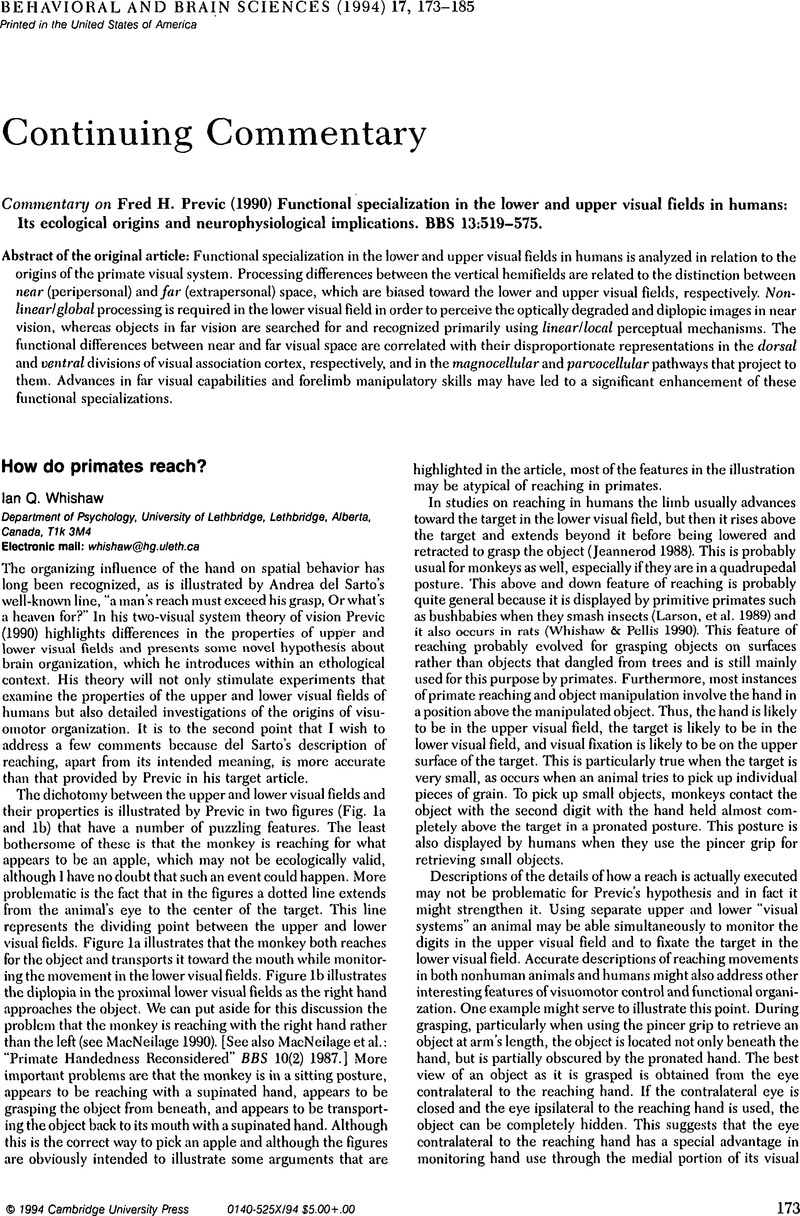No CrossRef data available.
Article contents
Neuropsychology and the art of reaching
Published online by Cambridge University Press: 04 February 2010
Abstract
An abstract is not available for this content so a preview has been provided. Please use the Get access link above for information on how to access this content.

- Type
- Author's Response
- Information
- Copyright
- Copyright © Cambridge University Press 1994
References
Goodale, M. A., Milner, A. D., Jakobson, L. S., fie Carey, D. P. (1991) A neurological dissociation between perceiving objects and grasping them. Nature 349:154–56. [rFHP]CrossRefGoogle Scholar
Guiard, Y. (1987) Precursors to what? Theory is lacking for handedness in humans. Behavioral and Brain Sciences 10:276–77. [rFHP]CrossRefGoogle Scholar
Jeannerod, M. (1988) The neural and behavioural organization of goaldirected movements. Clarendon Press. [rFHP, IQW]Google Scholar
Larson, C. F., Dodson, D. L. & Ward, J. P. (1989) Hand preferences and whole-body turning biases of lesser bushbabies (Galago senegalensis). Brain Behavior and Evolution 33:261–67. [IQW]CrossRefGoogle ScholarPubMed
MacNeilage, P. F. (1990) Grasping modern primates: The evolutionary context. In: Vision and action: The control of grasping, ed. Goodale, M.. Ablex Publishing. [IQW]Google Scholar
Maunsell, J. H. R. & Van Essen, D. C. (1987) The topographic organization of the middle temporal visual area in the macaque monkey: Representational biases and the relationship to callosal connections and myeloarchitectonic boundaries, Journal of Comparative Neurology 266:535–55. [rFHP]CrossRefGoogle ScholarPubMed
Mounteastle, V. B., Lynch, J. C., Georgopoulos, A. & Sakata, H. (1975) Posterior parietal association cortex of the monkey: Command functions for operation within extrapersonal space. Journal of Neurophysiology 38:871–908. [IQW]CrossRefGoogle Scholar
Paillard, J. (1982) The contribution of peripheral and central vision to visually guided reaching. In; Analysis of visual behavior, ed. Ingle, D. J., Goodale, M. A. & Mansfield, R. J. W.. MIT Press. [rFHP]Google Scholar
Perenin, M. T. & Vighetto, A. (1983) Optic ataxia: A specific disorder in visuomotor coordination. In: Spatially oriented behavior, ed. Hein, A. & Jeannerod, M.. Springer-Verlag. [rFHP]Google Scholar
Previc, F. H. (1990) Functional specialization in the lower and upper visual fields in humans: Its ecological origins and neurophysiological implications. Behavioral and Brain Sciences 13:519–59. [IQW]CrossRefGoogle Scholar
Previc, F. H. (1991) A general theory concerning the prenatal origins of cerebral lateralization in humans. Psychological Review 98:299–334. [rFHP]CrossRefGoogle ScholarPubMed
Whishaw, I. Q. & Pellis, S. M. (1990) The structure of skilled forelimb reaching in the rat: A proximally driven movement with a single distal rotatory component. Behavioral Brain Research 41:77–91. [IQW]CrossRefGoogle Scholar


